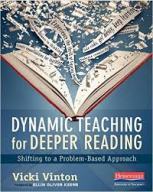
Ah, round two of the #cyberpd summer read. Chapters 5 and 6 are where Vinton dives into the practical aspects of teaching for deeper meaning and creating opportunities for problem-solving. This is my comfort zone when it comes to reading and thinking about educational practices; I’m a details person, a concrete thinker much of the time who needs to hear about the mechanics of how something works before I can really think about it with a wider lens.
Chapter 5 spoke to me in so many ways. Whether they are reading for pleasure or for class, kids have such a hard time with “figuring out the basics”. Chapters with alternating voices, books with flashbacks and time switches, too many pronouns, elements that I think make a book more interesting often make it confusing to students. They bring it back unread, telling me it was ‘boring’. Boring = “I didn’t get it, and I couldn’t figure it out”. Much of the time, but not always. So many kids read just for plot, they can’t recall the title of the book, characters’ names or details about the setting, but they can give me a play-by-play of the action. They miss the humor, the wordplay, the patterns, the world-building in a good fantasy or sci-fi; so much is lost in the whirlwind of reading quickly to see how it ends.
The core practices that are shared in both chapters have helped me to think about how I can adapt them to my work in the library to help students dig a little deeper in their reading, to appreciate a book for more than just the plot points. Or to just mark it as “read” on their mental lists of things they have accomplished.
-Can I use sophisticated picture books with 5th graders to demonstrate how to think deeply about a text in a 40-minute class period? Will they find ways to transfer that learning to their own reading? Some will, some won’t.
-Can I create some open-ended questions for kids to think about in their independent reading that isn’t text dependent so everyone can answer it within the context of their individual books? I’d like to think so.
-Could they do “Turn and Talks” about their independent reading answering three specific questions with their partner? Maybe.
It feels piecemeal, but maybe something is better than nothing. Or maybe, I can try things out with students, talk to teachers as I go, and find ways to collaborate more often throughout the school year.
I’m curious. As people read these chapters and reflect on their own teaching will you be completely overhauling what you do, or will you be trying bits and pieces to see how it goes? Do you have the flexibility in your workplaces to make big changes? I’ll definitely be reading people’s responses to these more practical chapters with that in mind. What about collaboration with other teachers in your school? Can you reach out to the science teachers to think about how kids read and respond to nonfiction texts? Or working with librarians to find new and different texts that might meet your needs?
As always, so much to think about.
And, here’s a pretty picture of blueberries that are just ripening in my backyard, making focus on work things difficult. What’s your distraction this summer?

I’m definitely NOT doing a total overhaul. Tweak-R-Us. Because on top of everything else, just found out we’re getting a new principal.
When I imagine next year, I can totally see us digging into “”Sometimes writers don’t come right out and tell us exactly what’s happening.” all. year. long. With fiction, with nonfiction, with read aloud, with #classroombookaday.
I’m going to try to lead by example and suggestion with my grade level team, one of whom will be the science/social studies teacher for my homeroom. As for finding texts, I’m going to keep that one to myself, since I’m the one who will know best what I’m looking for. Or maybe crowd source it on Twitter.
Distractions? Nothing as yummy as blueberries in my back yard! I’m hoping the black swallowtail butterflies will come back and start families on all the parsley and dill I planted for them!
LikeLiked by 2 people
I’ll join the Tweak-R-Us team. Luckily I don’t have to work with a set curriculum. My students write responses to reading and often struggle with the same issues of all plot and no critical thinking. I want to push them toward more CT and this book is helping me think about how.
Our blueberries ripened a while ago, late May. Now I have to buy them in a store.
LikeLiked by 1 person
I’m with you both on the tweaking things part. I also don’t have a set curriculum or set standards that I have to adhere to, so plenty of flexibility, but because I only see students once a week, I’m limited in other ways.
LikeLike
I also latched on to the “sometimes writers don’t come right out…” statement. So many ways to find out what a writer is trying to say, what they mean, what they hope the reader might get out of their book, etc…I imagine so many kids haven’t even thought of writing that way, have never considered the author in that light.
Also, I didn’t know the swallowtails like the parsley and dill. Hopefully, you’ll get some cool pics!
LikeLike
I will not be overhauling. I will teach different things that I maybe haven’t ever considered. I have always been a person for whom reading is easy. I read a lot, for learning and pleasure. I do so many things automatically! I need reminders, like those in these chapters, that there are people for whom none of it comes easily or automatically. I remember having a conversation several years ago with a student who just wasn’t getting the book. He couldn’t follow along with the changes in point of view. It was an eye opener for me, because that wouldn’t be hard for me. I appreciate Vinton focusing on these deep-thinking strategies that effect the most proficient readers – the ones we think are people just fine because they can read high levelled guided reading text. The whole game changes when you get a long book!
I love your idea for using picture books with older children (5th grade is older, right?) Picture books can be greta launch points for sophisticated reading strategies!
LikeLiked by 1 person
I, too, have always been a strong reader, but I have my deficiencies that I happily share with kids so they know that just because I read a lot doesn’t mean that I don’t struggle with things.
One of my goals this coming school year will be to incorporate more picture books into my work with middle schoolers. (Gr. 5-8).
LikeLike
Like you Lisa, I read a lot for learning and pleasure. In Chapters 5 and 6, Vinton named for me some of the things I am doing automatically as a reader to figure things out. I am excited to try out the What I Know/What I Wonder Chart and depicting connections leading to inferences with an equation to make the thinking my students are doing more visible. I will be adjusting what I already do to incorporate these practices. For example, we record our questions before, during, and after reading and then search for answers and record how we got them – in the text, by inferring, or going to an outside source. I can tweak this chart to have two columns to show what we wonder and the clues we added together to infer the answers or answers we found in the text. I almost think I might flip the chart to What We Wonder/What We Know.
LikeLike